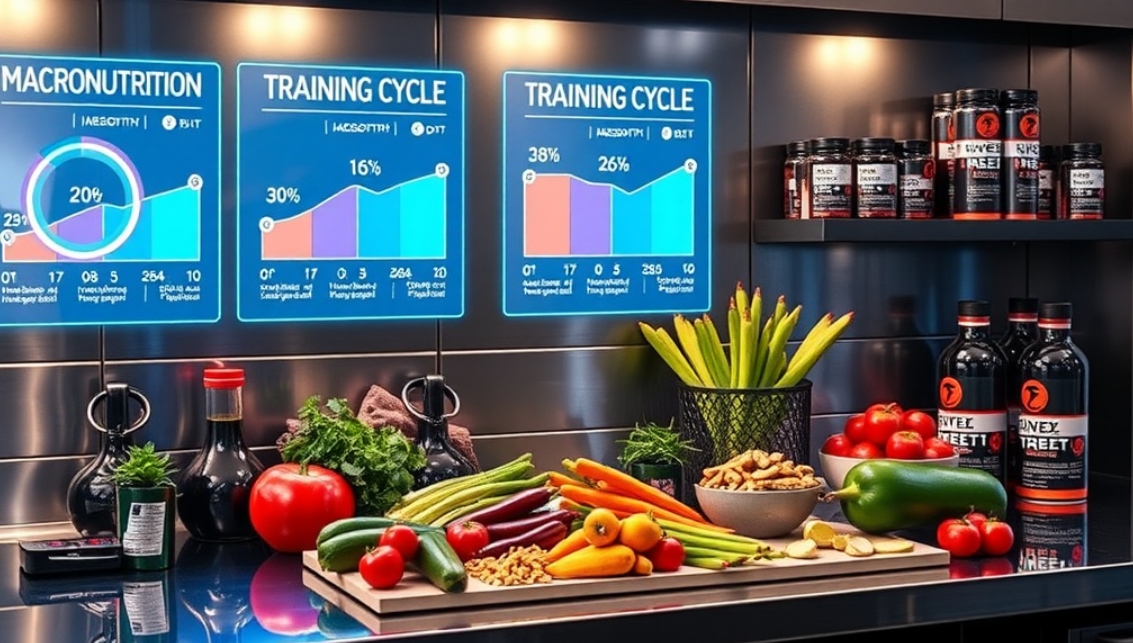Introduction
Imagine fine-tuning your body like a high-performance engine, where every fuel input is precisely calibrated for peak output. This is the essence of nutrition periodization, a strategic approach to eating that aligns your diet with your training cycles to optimize athletic performance and body composition.
Whether you’re an elite athlete, a dedicated bodybuilder, or a fitness enthusiast looking to take your results to the next level, understanding and implementing nutrition periodization can be a game-changer. In this comprehensive guide, we’ll explore the intricacies of periodized nutrition, from the fundamental concepts to advanced strategies, helping you unlock your full potential through strategic eating.
Understanding Nutrition Periodization: The Foundation of Strategic Eating
What is Nutrition Periodization?
Nutrition periodization is the systematic planning and implementation of diet changes to match the varying demands of training and competition cycles. Just as athletes periodize their training to peak at the right time, nutrition periodization involves strategically adjusting nutrient intake to support different phases of training, recovery, and performance.
The Science Behind Aligning Diet with Training Cycles
The concept of nutrition periodization is rooted in the body’s changing nutritional needs during different training phases. During high-intensity or high-volume training periods, the body may require more carbohydrates for energy and protein for recovery. Conversely, during lower-intensity phases or when focusing on fat loss, a lower-carb, higher-fat approach might be more appropriate.
Research has shown that matching nutritional strategies to specific training blocks can enhance adaptations to training stimuli, improve recovery, and optimize body composition changes.
Benefits of Periodized Nutrition for Athletes and Fitness Enthusiasts
- Enhanced performance: By providing the right nutrients at the right time, nutrition periodization can help improve strength, endurance, and overall athletic performance.
- Improved body composition: Strategic manipulation of macronutrients and calories can facilitate muscle gain during bulking phases and fat loss during cutting phases.
- Better recovery: Aligning nutrition with training intensity can support faster and more effective recovery between workouts.
- Reduced risk of plateaus: Regular adjustments to the diet can help prevent adaptive resistance and continue progress.
- Optimized hormonal environment: Proper nutrition periodization can help maintain a favorable hormonal balance for performance and body composition goals.
Key Components of a Nutrition Periodization Plan
Macronutrient Manipulation: Protein, Carbs, and Fats
The cornerstone of nutrition periodization is the strategic adjustment of macronutrients:
- Protein: Generally kept high throughout all phases (1.6-2.2g per kg of body weight) to support muscle maintenance and growth.
- Carbohydrates: Adjusted based on training intensity and volume. Higher during intense training phases, lower during cutting or low-intensity periods.
- Fats: Often inversely related to carbohydrate intake, providing essential nutrients and hormonal support.
Calorie Cycling: Fueling Performance and Body Composition Goals
Calorie cycling involves alternating between higher and lower calorie intakes to support performance and body composition goals:
- Bulking phases: Slight caloric surplus to support muscle growth
- Cutting phases: Moderate caloric deficit to promote fat loss while preserving muscle
- Maintenance phases: Balanced calorie intake to sustain current body composition
Nutrient Timing: Optimizing Intake Around Workouts
Strategic timing of nutrient intake can enhance performance and recovery:
- Pre-workout nutrition: Focus on easily digestible carbs and some protein
- Intra-workout nutrition: Typically includes fast-acting carbs and essential amino acids for longer sessions
- Post-workout nutrition: Emphasis on protein for recovery and carbs to replenish glycogen stores
Creating an Annual Supplement Plan
An annual supplement plan can complement your nutrition periodization strategy:
- Year-round basics: Multivitamin, omega-3s, vitamin D
- Performance-enhancers: Creatine, beta-alanine during intensive training phases
- Recovery-aids: Whey protein, BCAAs, especially during high-volume training
- Cutting-phase support: Fiber supplements, caffeine (if tolerated)
Implementing Nutrition Periodization: From Bulking to Cutting
The Bulking Phase: Strategic Muscle Gain
During a bulking phase, the goal is to build muscle mass:
- Calorie surplus: Aim for 10-20% above maintenance calories
- High protein intake: 1.6-2.2g per kg of body weight
- Moderate to high carb intake: To fuel intense workouts and support muscle growth
- Moderate fat intake: To support hormonal function
The Cutting Phase: Lean Mass Preservation During Fat Loss
The cutting phase focuses on losing fat while maintaining muscle:
- Calorie deficit: Aim for 20-25% below maintenance calories
- High protein intake: To preserve muscle mass (up to 2.2g per kg or more)
- Moderate carb intake: Enough to fuel workouts, but reduced to promote fat loss
- Moderate to low fat intake: Balanced to support hormonal function while in a deficit
Maintenance Phases: Sustaining Progress and Recovery
Maintenance phases are crucial for solidifying gains and allowing the body to recover:
- Balanced calorie intake: Matching energy expenditure
- Moderate and balanced macronutrient distribution
- Focus on nutrient-dense foods to support overall health
Advanced Nutrition Periodization Techniques for Athletes
Carb Cycling for Enhanced Performance and Body Composition
Carb cycling involves alternating between high, moderate, and low carb days:
- High carb days: Coincide with most intense training sessions
- Moderate carb days: For moderate intensity or volume workouts
- Low carb days: Often on rest days or during cutting phases
Macro Adjustments Based on Workout Intensity and Volume
Fine-tuning macros based on daily training demands:
- Higher carbs and calories on intense training days
- Lower carbs and calories on rest or light training days
- Consistent protein intake across all days
Reverse Dieting: Rebuilding Metabolism After Competition
Reverse dieting involves slowly increasing calories post-competition:
- Gradual increase in carbs and fats
- Monitoring body composition and adjusting as needed
- Aim to find new maintenance calorie level
Customizing Your Nutrition Periodization Plan
Factors to Consider: Sport, Goals, and Individual Differences
- Sport-specific demands: Endurance vs. strength vs. mixed sports
- Individual metabolic differences: Some may thrive on higher carbs, others on higher fats
- Personal preferences and lifestyle factors
Tools and Resources for Tracking and Adjusting Your Plan
- Food tracking apps: MyFitnessPal, Cronometer
- Body composition measurement tools: DEXA scans, bioelectrical impedance scales
- Performance tracking apps and devices
Working with a Sports Nutritionist or Dietitian
Professional guidance can be invaluable in creating and adjusting your nutrition periodization plan, especially for high-level athletes or those with complex goals.
Overcoming Challenges in Nutrition Periodization
Managing Metabolic Adaptations
- Regular diet breaks or re-feeds
- Periodic diet reversals
- Monitoring and adjusting based on progress and feedback
Psychological Aspects of Changing Eating Patterns
- Mindset strategies for different phases
- Dealing with hunger during cutting phases
- Avoiding obsessive behaviors around food
Balancing Social Life and Strict Nutrition Plans
- Flexible dieting approaches
- Strategies for eating out while staying on track
- Communicating your goals and needs to friends and family
Conclusion
Nutrition periodization is a powerful tool for maximizing athletic performance and achieving body composition goals. By strategically aligning your diet with your training cycles, you can optimize your body’s response to training stimuli, enhance recovery, and achieve peak performance when it matters most.
Remember, the key to successful nutrition periodization is consistency, patience, and a willingness to adjust based on your body’s feedback. Whether you’re a competitive athlete or a dedicated fitness enthusiast, implementing these strategies can help you take your performance and physique to the next level.
Start by assessing your current training cycle and nutritional habits, then gradually implement periodization strategies that align with your goals. With time and practice, you’ll develop a nuanced understanding of how your body responds to different nutritional approaches, allowing you to fine-tune your diet for optimal results.
FAQ Section
What is the difference between nutrition periodization and regular meal planning?
Nutrition periodization involves strategically changing your diet to match different training phases, while regular meal planning typically maintains a consistent approach regardless of training intensity or goals.
How often should I adjust my macros when following a periodized nutrition plan?
The frequency of adjustments depends on your training cycles and goals. Some athletes might adjust weekly, while others might have longer phases lasting several weeks or months.
Can nutrition periodization help with weight loss plateaus?
Yes, by systematically varying calorie and macronutrient intake, nutrition periodization can help overcome weight loss plateaus and continue progress.
Is carb cycling necessary for all athletes implementing nutrition periodization?
While carb cycling can be beneficial, it’s not necessary for everyone. Its usefulness depends on individual goals, sport demands, and personal response to different carb intakes.
How do I create an annual supplement plan as part of my periodized nutrition strategy?
Start by identifying your core, year-round supplements (like a multivitamin and omega-3s). Then, plan additional supplements based on your training phases, such as adding creatine during strength-building phases or specific recovery aids during high-volume training periods.



